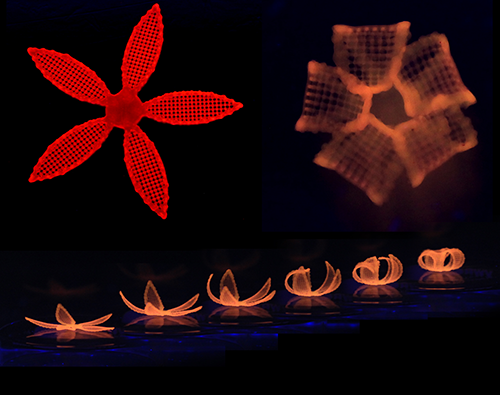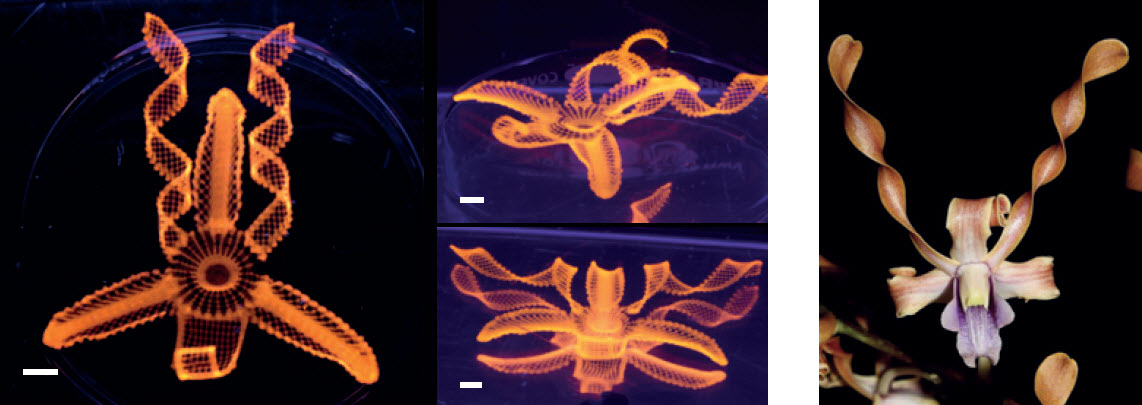A novel ‘4D printing’ method inspired by plants
January 26, 2016

This series of images shows the transformation (top right) of a 4D-printed hydrogel composite structure (top left) after its submersion (bottom) in water (credit: Wyss Institute at Harvard University)
Harvard University scientists have evolved their microscale 3D printing technology to the fourth dimension, time. Inspired by natural structures like plants, which respond and change their form over time according to environmental stimuli, the team has designed 4D-printed hydrogel composite structures that change shape upon immersion in water.
The team is located at the Wyss Institute for Biologically Inspired Engineering at Harvard University and the Harvard John A. Paulson School of Engineering and Applied Sciences.
“This work represents an elegant advance in programmable materials assembly, made possible by a multidisciplinary approach,” said Jennifer Lewis, Sc.D., senior author of a new study reported on January 25 in a new in Nature Materials. “We have now gone beyond integrating form and function to create transformable architectures.”
In nature, flowers and plants have tissue compositions and microstructures that result in dynamic morphologies (forms) that change according to their environments. Mimicking the variety of shape changes undergone by plant organs such as tendrils, leaves, and flowers in response to environmental stimuli like humidity and/or temperature, the 4D-printed hydrogel composites developed by Lewis and her team are programmed to contain precise, localized swelling behaviors.
Derived from wood
The trick: the hydrogel composites contain cellulose fibrils that are derived from wood and are similar to the microstructures that enable shape changes in plants.
By aligning cellulose fibrils during printing, the hydrogel composite ink is encoded with anisotropic swelling and stiffness, which can be patterned to produce intricate shape changes. The anisotropic (irregular) nature of the cellulose fibrils gives rise to varied directional properties that can be predicted and controlled. That’s why wood can be split easier along the grain rather than across it.
Likewise, when immersed in water, the hydrogel-cellulose fibril ink undergoes differential swelling behavior along and orthogonal to the printing path. Combined with a proprietary mathematical model developed by the team that predicts how a 4D object must be printed to achieve prescribed transformable shapes, the new method opens up many new and exciting potential applications for 4D printing technology including smart textiles, soft electronics, biomedical devices, and tissue engineering.
The composite ink that the team uses flows like liquid through the printhead, yet rapidly solidifies once printed. A variety of hydrogel materials can be used interchangeably resulting in different stimuli-responsive behaviors, while the cellulose fibrils can be replaced with other anisotropic fillers of choice, including conductive fillers.

Complex flower morphologies generated by biomimetic 4D printing. A flower demonstrating a range of morphologies inspired by a native orchid, the Dendrobium helix (courtesy of Ricardo Valentin). Based on the print path, this orchid architecture exhibits four different configurations: bending, twisting and ruffling corolla surrounding the central funnel-like domain (scale bars, 5 mm). (credit: A. Sydney Gladman et al./Nature Materials)
The mathematical model prescribes the printing pathways required to achieve the desired shape-transforming response. Specifically, it solves the “inverse problem” — the challenge of being able to predict what the printing toolpath must be to encode swelling behaviors toward achieving a specific desired target shape.
“It is wonderful to be able to design and realize, in an engineered structure, some of nature’s solutions,” said L. Mahadevan, Ph.D., a Wyss Core Faculty member as well as the Lola England de Valpine Professor of Applied Mathematics, Professor of Organismic and Evolutionary Biology, and Professor of Physics at Harvard University and Harvard SEAS, is a co-author on the study. “By solving the inverse problem, we are now able to reverse-engineer the problem and determine how to vary local inhomogeneity, i.e. the spacing between the printed ink filaments, and the anisotropy, i.e. the direction of these filaments, to control the spatiotemporal response of these shapeshifting sheets.”
Lewis is a Core Faculty member at the Wyss Institute for Biologically Inspired Engineering at Harvard University and the Hansjörg Wyss Professor of Biologically Inspired Engineering at the Harvard John A. Paulson School of Engineering and Applied Science (SEAS). Their team also includes co-author, Ralph Nuzzo, Ph.D., the G.L. Clark Professor of Chemistry at the University of Illinois at Urbana-Champaign.
Wyss Institute | 4D Printing: Shapeshifting Architectures
Abstract of Biomimetic 4D printing
Shape-morphing systems can be found in many areas, including smart textiles, autonomous robotics, biomedical devices, drug delivery and tissue engineering. The natural analogues of such systems are exemplified by nastic plant motions, where a variety of organs such as tendrils, bracts, leaves and flowers respond to environmental stimuli (such as humidity, light or touch) by varying internal turgor, which leads to dynamic conformations governed by the tissue composition and microstructural anisotropy of cell walls. Inspired by these botanical systems, we printed composite hydrogel architectures that are encoded with localized, anisotropic swelling behaviour controlled by the alignment of cellulose fibrils along prescribed four-dimensional printing pathways. When combined with a minimal theoretical framework that allows us to solve the inverse problem of designing the alignment patterns for prescribed target shapes, we can programmably fabricate plant-inspired architectures that change shape on immersion in water, yielding complex three-dimensional morphologies.